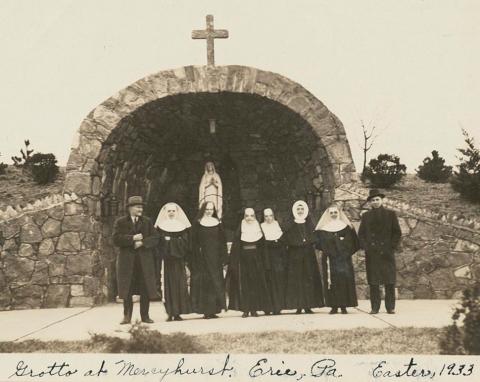History of the Grotto

Tucked away on the northwest side of campus is the Grotto, a shaded, peaceful place for reflection, conversation, and study. Modeled after the famous Grotto at Lourdes, France, a popular pilgrimage site for Catholics, the Mercyhurst Grotto features an alcove containing a white statue of Our Lady of Lourdes, an altar, and kneelers, with several benches spread throughout the surrounding lawn. The Grotto was designed by William Sullivan, Mercyhurst’s first chaplain. Sullivan was a central figure in early Mercyhurst history, as he also designed the driveway in front of Old Main and planned the creation of a lake to address water drainage issues. Sullivan Hall, located on the rise above the Grotto, is named for him.

The construction of the Grotto came at a time when many Americans were experiencing desperate times in the midst of the Great Depression. While the Sisters of Mercy certainly had their hands full running a new college, they also sought to alleviate the suffering in their surrounding community. One way they did this was by running a daily kitchen to serve food to those in need. It was from the kitchen’s clientele that Sullivan found the labor resources he needed to build the Grotto. The recruited men were glad to repay the Sisters for their generosity, and they got to work moving boulders and turning Sullivan’s vision into reality.

The Grotto initially featured a much larger statue of Mary, one that was too large to fit within the alcove as envisioned. It also held a statue of St. Bernadette, the young girl to whom Mary appeared at Lourdes. Orva O’Neil, the benefactor of O’Neil Tower and Christ the King Chapel, funded the venture with money left over from a family trip to Europe. She also donated these original statues in honor of her daughter, Mary.

Since its creation, the Grotto has been one of Mercyhurst’s unique features. For years, it was the site of the annual May Day festivities. Sadly, the original Mary statue was vandalized in 1992, and the location of the St. Bernadette statue is unknown. The pieces of the first Mary statue are buried at the Grotto, and the replacement statue was ordered to fit within the Grotto alcove as originally planned. Today, students can find solitude in the beautiful tranquility of the Grotto at any time of year. While May Day festivities were eventually moved to the front campus and then ended altogether, the Grotto is the site of annual Masses at the start and end of each school year, as well as a location for events like the Mercy March for Black Lives. The Grotto’s origins as an effort motivated by generosity and gratitude and its function as a place of prayerful contemplation make it a true embodiment of the Mercy mission.